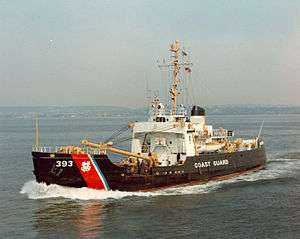USCGC Firebush (WLB-393)
 USCGC Firebush underway. | |
| History | |
|---|---|
| Name: | USCGC Firebush (WLB-393) |
| Builder: | Zenith Dredge Corporation |
| Laid down: | 12 November 1943 |
| Launched: | 3 February 1944 |
| Commissioned: | 20 July 1944 |
| Decommissioned: | 26 May 2003 |
| Fate: |
|
| Badge: |
 |
| History | |
| Name: | NNS Nwamba (A 503) |
| Commissioned: | 30 June 2003 |
| Identification: | MMSI number: 657710000 |
| Status: | Active as of July, 2015 |
| General characteristics | |
| Class and type: | Iris-class buoy tender |
| Displacement: | 935 long tons (950 t) |
| Length: | 180 ft (55 m) |
| Beam: | 47 ft 1 in (14.35 m) |
| Draft: | 12 ft (3.7 m) |
| Propulsion: | 1 × electric motor connected to 2 Westinghouse generators driven by 2 Cooper Bessemer-type GND-8, 4-cycle diesels; single screw |
| Speed: |
|
| Complement: |
|
| Armament: |
|
The USCGC Firebush (WLB-393) was a Iris-class buoy tender belonging to the United States Coast Guard launched on 3 February 1944 and commissioned on 20 July 1944.[1] She was eventually transferred to the Nigerian Navy in June 2003.
Design
The Iris-class buoy tenders were constructed after the Mesquite-class buoy tenders. Firebush cost $926,446 to construct and had an overall length of 180 feet (55 m). It had a beam of 37 feet (11 m) and a draft of up to 12 feet (3.7 m) at the time of construction, although this was increased to 14 feet 7 inches (4.45 m) in 1966. It initially had a displacement of 935 long tons (950 t; 1,047 short tons); this was increased to 1,026 long tons (1,042 t; 1,149 short tons) in 1966. It was powered by one electric motor. This was connected up to two Westinghouse generators which were driven by two CooperBessemer GND-8 four-cycle diesel engines. It had a single screw.[2]
The Iris-class buoy tenders had maximum sustained speeds of 13 knots (24 km/h; 15 mph), although this diminished to around 11.9 knots (22.0 km/h; 13.7 mph) in 1966. For economic and effective operation, it had to initially operate at 8.3 knots (15.4 km/h; 9.6 mph), although this increased to 8.5 knots (15.7 km/h; 9.8 mph) in 1966. The ship had a complement of six officers and seventy-four crew members in 1945; this decreased to two warrants, four officers, and forty-seven men in 1966. It was fitted with a SL1 radar system and QBE-3A sonar system in 1945. Its armament consisted of one 3″/50 caliber gun, two 20 mm/80 guns, two Mousetraps, two depth charge tracks, and four Y-guns in 1945; these were removed in 1966.[2]
Career
| International radio call sign of USCGC Firebush (WLB-393)[1] | |||
| |
|
|
|
| November | Oscar | Delta | Lima |
The Firebush was fire assigned to the 3rd Coast Guard District and homeported in St. George, Staten Island where she was used for ATON duties during the end of World War II.[1] In June 1979, she was transferred to Kodiak, Alaska to assist with ATON in Alaskan waters. During her time there, she tended 140 aids to navigation including 83 buoys. In May 2003 the Firebush was decommissioned and turned over to the Nigerian Navy.[1]
See also
References
- 1 2 3 4 "USCG Firebush". USCG. US Coast Guard. Retrieved 26 July 2015.
- 1 2 "Firebush". United States Coast Guard. Retrieved 24 August 2015.